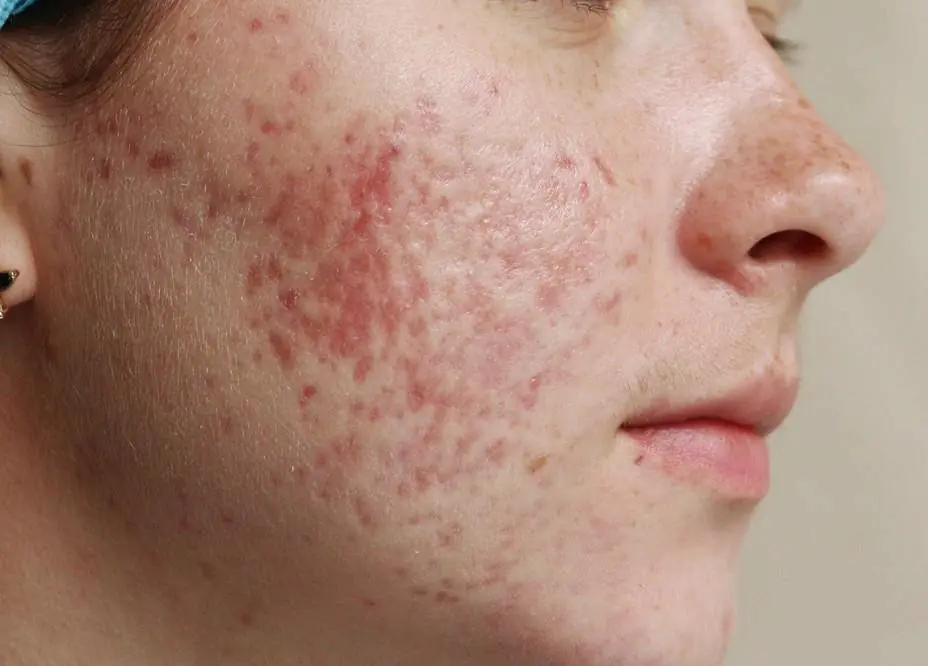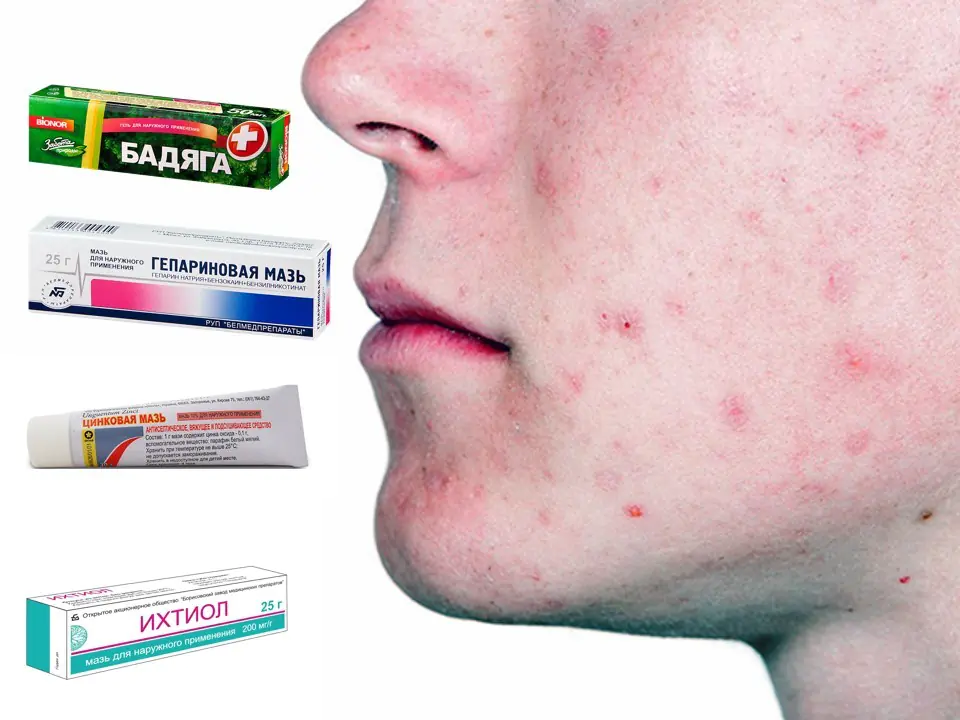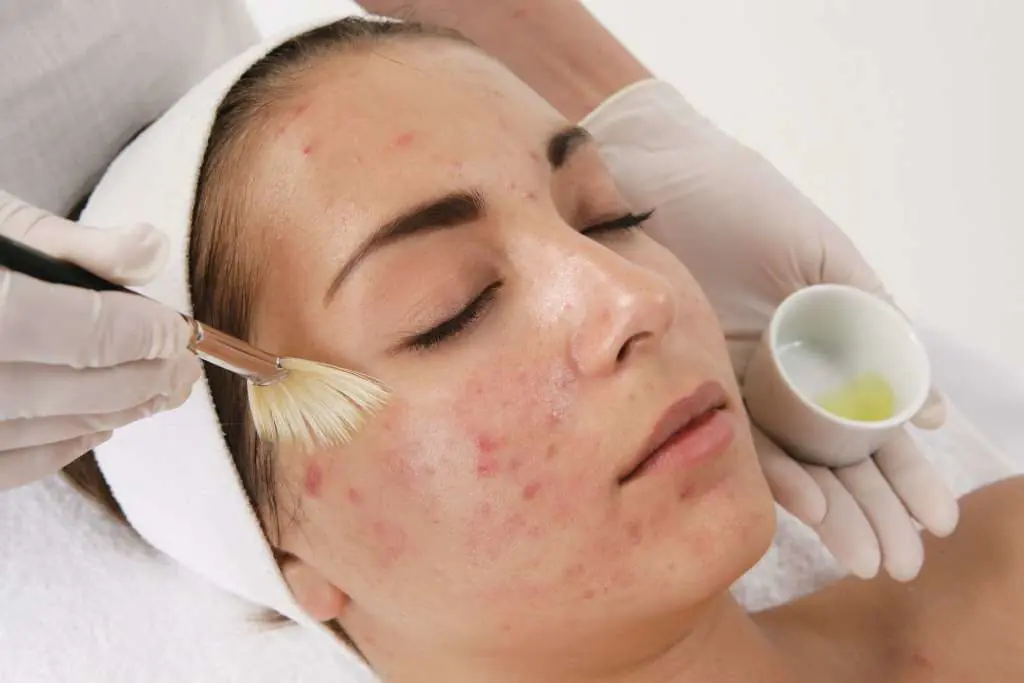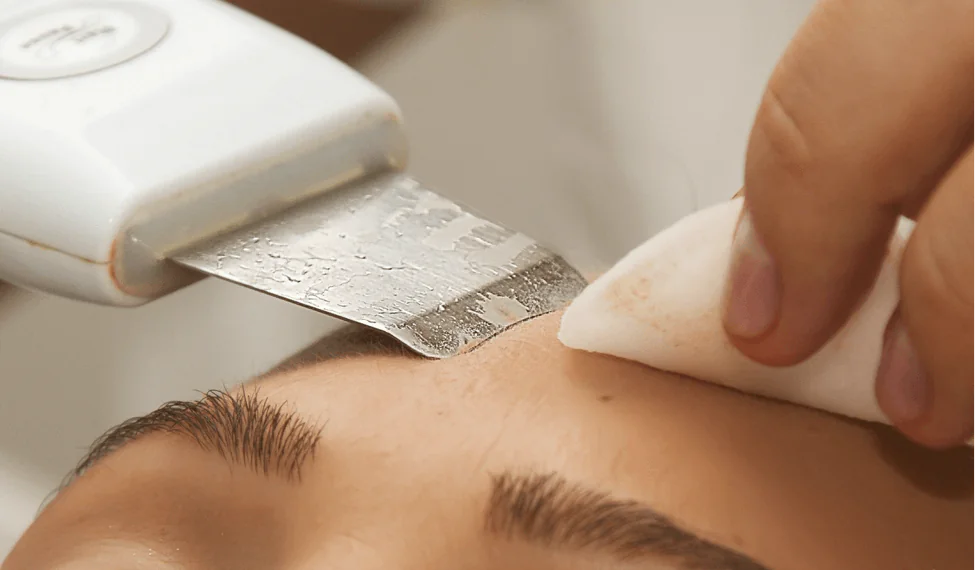At the end of acne treatment, various formations may appear on the skin, so an effective way to combat facial scars after acne is to use a cream that can be used at home. There are a huge number of such products, and they differ from each other in composition, mode of action and application. Despite positive reviews about any type of product, before you start dealing with skin defects, it is important to consult with a specialist.
The principle of action and effectiveness of scar creams
The cream for acne marks on the face is applied to a cleansed face. It is necessary to follow the instructions exactly; in some cases, the products are used in the form of lotions. To do this, apply the product to a small piece of gauze or a cotton pad and apply it to the affected area for 15 minutes. The procedure is performed 2-6 times a day. Open wounds should not be treated to prevent infection.
Good to know! Do not apply the cream to the area of skin close to the mucous membrane of the eye, or in places where a tumor has formed.
By using anti-scar creams, the following results are achieved:
- the size of scars decreases;
- skin tone changes;
- the affected areas soften;
- the growth of scar tissue is blocked;
- bacteria that are located in the deeper layers of tissue are destroyed;
- restorative processes are stimulated.
Creams affect blood vessels, dilating them, thereby improving blood circulation. They restore damaged blood vessels, improving skin regeneration. Some drugs have a lightening effect.
Types of scars
After damage, healthy connective tissue is replaced by scar tissue, which is classified according to the number of modified cells that appear. Types of scars:
- Atrophic, which form at the site of damage, and the replaced tissue is less than healthy. Most often, such damage is associated with stretch marks.
- Hypertrophic, which are formed above the surface of the tissue due to a large amount of scar tissue. After a while they become a different color and are not so noticeable.
- Keloids are characterized by pain and itching. Their shape may change and increase in size.
Scars can form on any part of the skin, but they are most uncomfortable when they appear on the face. For facial scars at home, you can use ointments, gels, and creams. There are various methods of effective control that can be selected, taking into account the individual tolerance of the components of the product, cost and type of scars.
Several factors may influence their appearance:
- Squeezing out blackheads. During such a procedure, there is a risk of infection, and the area of damaged tissue increases.
- Advanced acne can cover new areas of the skin. And after acne, spots may remain and scars may form.
- Parasitic infections provoke severe inflammation and cause skin damage.
During the inflammatory process of the skin and the appearance of acne, the blood vessels dilate and do not repair themselves, which provokes the formation of spider veins. Therefore, it is important to carefully select a product for each specific skin problem.
The best cosmetics for acne marks
There is a huge selection of products with different effects on the skin.
- Contractubex is an effective remedy for scars and acne scars, the effectiveness of which is achieved thanks to the active components of the cream. The composition contains heparin, which stimulates the formation of new cells and has restorative, moisturizing, softening effects. Allatoin is responsible for elasticity and skin turgor. Relieves inflammation and itching. Thanks to this component, the therapeutic effect is achieved by penetrating into the dermis. Natural onion extract reduces allergies and stops further scar formation. Itching may occur during use of the product, but this is not a reason for concern or discontinuation of therapy. The only contraindication is pregnancy and lactation.
- Panthenol is an effective anti-scar cream. It can be used in the form of foam, cream, ointment. Apply to the affected skin. Panthenol improves blood circulation and has restorative effects.
- Kelofibradze is a healing cream for the face after acne. In addition to the therapeutic effect, the product affects the water balance of the skin, helping to achieve smoothness and silkiness. It is rubbed in with light massage movements for 5 minutes, and in some cases you can make a compress for the whole night.
We invite you to look at a review of the best products for caring for a problem face:
All products are safe and accessible to everyone. In some cases, there are age restrictions, but you can find out about them by reading the instructions carefully. Similar medicinal drugs are:
- Achromin cream with whitening effect. It is used to even out facial tone and remove blemishes on the skin.
- Skinoren Gel is a successful remedy for solving acne problems during adolescence.
- Solcoseryl gel enhances skin metabolism. It contains blood serum components.
- Syntomycin ointment has antibacterial, anti-inflammatory, and analgesic effects. The result can be felt in 1-2 weeks. The drug may cause an allergic reaction in the form of redness and itching of the skin.
- Skinor cream that combats age spots. It is applied pointwise, only to problem areas.
All drugs are very easy to use and can be used for a long period. In addition, the following drugs are a budget option:
- Vishnevsky ointment (heals wounds, smoothes scars);
- zinc ointment, which has an exfoliating effect and enhances skin regeneration;
- salicylic ointment helps soften the stratum corneum of the epidermis;
- bodyaga forta (has a smoothing effect, increases blood circulation).
They can be bought at pharmacies without prescriptions. Some products have a strong odor and should be used with caution as they may cause tearing. Certain preparations contain plant extracts, essential oils, and also enriched with essential vitamins A, E, C.
Summary
In order to remove acne marks on the face, you need to be patient, as this is a fairly long process. To restore the beauty of your face, you need to use creams for a year or more. It all depends on the individual characteristics of the skin and how long ago the scar appeared.
Before you start using scar creams, it is important to test for an allergic reaction. To do this, apply a little product to the inside of the wrist, at the elbow crease. If redness and itching appear within a few minutes, then you should choose another drug. You should also be careful when applying different products simultaneously to the same area of skin; a chemical reaction of the two environments may occur and provoke undesirable consequences.
To get rid of scars, you need to choose a product individually, depending on the size and type.
Important! People with the same skin problems may not always be suitable for the same products. The structure of the connective tissue is different, and accordingly there is a difference in the recovery processes. Therefore, you should not self-medicate, but rather consult a professional cosmetologist who will help you choose an effective remedy.
To ensure that no trace remains on your face after acne appears, you need to properly take care of the beauty of your face. To do this, you can follow simple tips:
- eat right, include more vegetables and fruits in your diet;
- treat acne immediately after they form;
- do not squeeze or pick off pimples;
- at the final stage of acne healing, use products that affect accelerated skin regeneration (creams with vitamins A and E).
Interesting! Although foundation does not have a healing effect, applying it to the face can mask facial skin defects. In the summer, when the work of the sweat glands intensifies, you can use loose powder.
Many people dream of beautiful and well-groomed skin, but anyone can face difficulties such as acne and comedones, regardless of gender and age. Sometimes this is not limited to this, and after the pustules disappear, residual effects in the form of red or dark spots and even scars can be observed. Among the large number of medical and cosmetic drugs, it is important to understand which ointment for acne marks is best and what procedures are most effective to cure them. But in order to choose the right treatment package, you first need to understand how spots and scars arise after pustules.
What is post-acne and the reasons for its appearance?
Acne spots are secondary congestive skin phenomena that appear as a result of acne treatment or a prolonged inflammatory process. As a result, injured tissue is replaced by scar or connective tissue. Typically, acne marks have a reddish, blue or brown tint. 
There are several types of spots from pustules that may appear after healing from acne and pustular inflammation on the upper layer of the epidermis:
- Cuperosis (changes in blood vessels). Disruption of capillaries, and as a result of blood circulation and the appearance of vascular webs and redness. Those with thin and sensitive skin are most susceptible. Appears as a result of mechanical action, frequent and protracted inflammatory processes in the dermis.
- Scarring. They are formed by the growth of connective scar tissue in the lower layers of the skin at the site of protracted inflammatory pustular rashes. They usually have the shape of craters. They are most effectively treated when undergoing a course of salon procedures.
- Dyschromia (abscess marks) is a change in the pigmentation of the upper layer of the epidermis due to a deficiency or excess of melanin. The color depends on the depth of the inflamed pustule. Accordingly, the deeper the lesion, the darker the post-acne it leaves on the skin of the face. Ointment for acne spots, masks, and scrubbing can help get rid of mildly pigmented marks.
- Enlarged pores. A consequence of increased activity of the sebaceous glands during an exacerbation.
Basically, similar consequences from pustules and comedones have a joint manifestation on the dermis and require complex treatment. The process is rarely quick, so you shouldn't expect results in a week. A complete cure can be achieved if you pay attention to the existing problem in time and take appropriate measures.
There are several reasons for the appearance of traces of inflammatory processes on the skin of the face:
- large scale of damage to the dermis;
- deep location of pustules;
- injury to the protective layer during mechanical cleaning of the epidermis;
- improper treatment of the inflammatory process;
- lack of treatment as such;
- predisposition to facial skin that is too sensitive to inflammatory processes.
How to prevent the consequences of acne
To minimize the possibility of acne spots, you need to treat them promptly. The optimal solution is to combine home and salon care:
- use high-quality cleansers that regulate the functioning of the sebaceous glands;
- consult a specialist about the causes of acne and comedones;
- regularly visit a beauty salon for professional cleaning;
- use creams with a sun protection factor of at least 30 SPF to avoid changes in pigmentation of the epidermis;
- At the time of post-acne treatment, decorative cosmetics should be abandoned.
Types of remedies for scars and blemishes on the face
There is a huge variety of products, drugs and services to get rid of the consequences of congestive inflammation on the face in the form of spots and scars.
Pharmacy products
- Hydrogen peroxide 3%. Helps disinfect the surface of the epidermis and accelerate the healing of the skin from post-acne.
- Salicylic alcohol. Used to disinfect the protective layer of the skin and before subsequent application of a remedy for red spots after acne.

- Ointment for acne marks Vishnevsky. A very common and effective remedy for external use. Has anti-inflammatory, wound-healing, disinfecting effects. Use 2 times a day, apply pointwise to problem areas. The course of treatment is for 20 days.
- Heparin ointment for acne spots accelerates the regeneration of the protective covering, has an analgesic, softening and anti-inflammatory effect. Apply to the lesions 3 times a day for one week.
- Contratubeks. This ointment for acne marks on the face acts as a softening, regenerating and disinfectant. Apply to marks or scars from pustules 2-3 times a day. The course of treatment can vary from 3 months for new scars to 6 months for stagnant scars.
- Badyaga. Treats inflammation, improves elasticity and blood supply to the upper layer of the dermis, removes dead scales of the epidermis. Spot application to the scar for half an hour, followed by rinsing. If it burns, wash it off immediately.
- Kelofibrase. Eliminates old scars and spots, thanks to it the skin becomes more elastic and fresh. The course of application can vary from 6 weeks to six months, depending on the age of the scars.
- Clearvin. The cream acts as a moisturizing, regenerating, softening, healing agent. Rub into skin 2 times a day for 2 months.
Folk remedies
- A mask made from whipped egg white with the addition of 2 teaspoons of lemon juice will help against dark spots and scars. This mixture perfectly whitens the skin. If there is no need to bleach your entire face, you can use this mixture and apply it directly to the marks, leave for 15 minutes, then rinse with cool water.
- A parsley mask, rich in vitamins and microelements, refreshes the skin and accelerates the healing process of acne spots. Finely chop, mash a little until the juice appears, then apply to the face or acne. Wash off after 15 minutes.

- A mixture of tomato pulp, potato starch and grated cucumber is very effective for healing the epidermis from red marks after acne. The mask is prepared quite simply - 3 parts tomato, 1 part starch and 1 part cucumber. Apply for 15 minutes, then wash.
- St. John's wort tincture, which is famous for its healing and disinfecting properties, is very effective. Add 1 tablespoon of ethyl alcohol to 2 tablespoons of herbs and leave to brew in a dark, cool place for 10 days. Wipe stains daily until they disappear completely.
- Masks based on cosmetic clays (blue, green) will also be very effective, as they perfectly relieve skin inflammation and cleanse. To enhance the effect of clay, you can add kefir to such masks (it soothes the skin well), aromatic oils of tea tree, lemon, orange, rosemary, ylang-ylang.
Salon treatments
- Chemical peeling. Gentle modern formulations of products are used, consisting of retinol, fruit, azelaic and salicylic acids. After use, it is advisable to apply a sunscreen with an SPF of at least 30 to your face.
- Mesotherapy. Injecting the face with a vitamin cocktail. Helps improve complexion and tighten enlarged pores.
- Biorevitalization. Injections with authentic hyaluronic acid into the lower layers of the epidermis. Thanks to this, the skin is quickly moisturized and the vital processes of cells improve. The restoration of the protective cover occurs through the regeneration of one’s own skin.
- Laser cleaning. The non-contact technique helps tighten pores, removes dead cells, normalizes color and rejuvenates the protective covering.

- Ultrasonic cleaning. An effective procedure for getting rid of post-acne. Gently removes the top layer of dermis. Normalizes metabolism in the epidermis. Improves the condition of the protective cover, evens out color, increases firmness and elasticity.
- Vacuum cleaning. Cleanses pores of impurities, tightens the skin and saturates it with oxygen. Easily removes old cells, thereby normalizing color.
- LED therapy. Using different colors of lamps you can achieve the desired result. Green helps improve skin tone and heal post-acne; Red – causes the epidermis to intensively produce collagen; blue – destroys areas of skin abscesses.
- Dermabrasion. Using this method of cleansing the dermis, scars and post-operative scars, as well as age wrinkles, can be effectively removed. The method of deep cleansing the skin removes dead particles of the epidermis.
Prevention recommendations
For the post-acne problem to disappear, you need to:
- ensure daily proper hygiene of the facial skin;
- before taking any step to treat or cleanse your facial skin, consult a dermatologist or cosmetologist for an individual selection of procedures and medications;
- entrust the cleaning of the protective cover to a qualified specialist;
- It is most effective to carry out comprehensive care, combining home procedures and salon services;
- When carrying out mechanical cleaning yourself, observe hand hygiene.
If prevention, salon treatment and ointment for acne marks do not give the desired result, you need to contact specialists of another profile: endocrinologist, gastroenterologist, infectious disease specialist and gynecologist. In any case, do not despair, because post-acne can be cured, you just need to be patient.
During adolescence, the most common problem for most people is pimples and acne on the face - in addition, such formations on the skin can occur during pregnancy and due to poor-quality cosmetics. In order to combat this problem, hundreds of different creams, ointments, tonics, masks and other pharmaceutical and cosmetic products have been developed. However, after the problem of acne seems to be solved, a new one appears in the form of traces of these inflammatory processes, which in cosmetology are known as post-acne.

Post-acne – reasons for its appearance
In order to understand exactly how to deal with the problem of acne marks and pimples, it is necessary to at least in general understand the reasons for the development of these formations. The main reason for the development of acne is the malfunction of the sebaceous glands, which produce a secretion called sebum - it covers the surface of the skin with a thin layer, softens it and normalizes the composition of the microflora. But due to various factors of internal and external nature (hormonal imbalances, blockage of gland ducts with cosmetics), secretion becomes difficult. Sebum changes its consistency, becomes thicker and cannot be released onto the surface of the facial skin, but begins to accumulate in the ducts, expanding them. This is the first stage of a complex of disorders, which then leads to the development of acne and post-acne.
Another reason for changes in the secretion of the sebaceous glands are metabolic changes that develop, among other things, due to poor nutrition. This is what causes the development of acne after eating fatty and fried foods.
After this, the enlarged pores and ducts of the glands with fatty contents become an easy target for various microorganisms that begin to feed on sebum. Their massive reproduction causes a reaction in the body (inflammation), the intensity of which depends on many factors - individual characteristics, the nature of the microflora, the activity of the sebaceous glands. The proliferation of microorganisms and the inflammatory reaction leads to local dilation of blood vessels, swelling, and partial destruction of tissue. It is at this stage that acne is observed - local areas of inflammation.
The fight against acne marks in the form of scars and blemishes should begin at this stage. The simplest anti-inflammatory ointment or antiseptic can significantly reduce inflammation and destruction of skin tissue, which will subsequently significantly reduce the severity of post-acne.
Finally, after the inflammation subsides, gradual recovery of the affected areas begins. It can occur both physiologically, that is, with the restoration of the normal structure of the facial skin (as a result, there are simply no traces of pimples and acne), or somewhat differently. For example, vessels dilated as a result of inflammation may not return to their previous state, which is the cause of persistent red spots. In the place of former acne, after inflammation subsides, rough connective tissue often appears, which is the cause of the development of various scars. Inflammation can also stimulate the proliferation of skin pigment cells - melanocytes. This leads to the development of brown spots at the site of inflammation.
The method of eliminating post-acne depends on the type of such disorder. This also applies to the choice of ointment to combat acne and pimple marks - at the moment there is no universal remedy against all such disorders.
Ointments against various types of post-acne
Depending on the type of acne marks, you need to use different means to eliminate them. Typically, post-acne is divided into two large groups - spots and scars, which are a special type of scars. In addition, each of these groups has its own varieties, for example, experts distinguish from two to four types of the same scars.
Vascular spots
One of the common reasons for the appearance of post-acne in the form of red spots and dots is the pathological expansion of blood vessels in the area of the healed inflammation. With the development of acne, dilation of blood vessels ensures that biologically active substances enter the pathological focus of immune system cells. But in some cases, after the inflammation stops, the vessels “forget” to contract, which causes the appearance of persistent red spots. In order to eliminate such a disorder on the face, the following ointments and gels are used:
- Badyaga forte. This seaweed-based product contains many microscopic silica needles. Due to this, when applying the product, an “acupuncture massage” occurs at the microscopic level, which slightly dilates the blood vessels. But on the contrary, they need to be narrowed down? The thing is that after such stimulation the body strives to return the vessels to their original state and at the same time can narrow the pathologically dilated arterioles. To eliminate red spots, apply a small amount of ointment to the skin of the face and rub it over the entire surface with light circular movements. After 20 minutes, the remaining ointment is washed off with warm water, this procedure is repeated 2-3 times a week until the spots disappear.
- Panthenol. This product in the form of ointment and foam has an excellent restorative effect. At the same time, one of the aspects of the regenerating effect of Panthenol is the normalization of blood circulation in tissues, so it can eliminate pathological vasodilatation. The ointment must be applied daily to the skin of the face.
Such spots can ultimately lead to other vascular disorders of the facial skin - telangiectasia, or spider veins. Such conditions cannot be eliminated with ointments alone; the intervention of hardware cosmetology will be necessary.
Dark spots
Under the influence of inflammation and some other factors (ultraviolet radiation, for example), melanocytes begin to develop more actively around acne and scars after them. This ultimately leads to the appearance of brown spots and acne marks. Sometimes another situation occurs - the proliferation of pigment cells slows down and then an area lighter than the rest of the skin appears around scars and healed pimples. To combat these disorders, the following ointments are used:
- Skinoren - the only active ingredient of this product is azelaic acid. It has a normalizing effect on pigment metabolism in the skin and slows down the excessive proliferation of melanocytes. In the case of age spots, this ointment is applied pointwise, directly to areas of hyperpigmentation, 2 times a day.
- Ointments and creams containing kojic acid work well to lighten areas of hyperpigmentation around scars and acne scars.
- In the case where acne marks look like areas of reduced pigmentation, correcting the problem with ointments becomes much more difficult. Most often, cosmetologists advise improving pigment metabolism on the entire face with the help of ointments and creams with vitamins A, E and other nutritional ingredients.
Age spots are a common disorder following acne caused by pregnancy or hormonal problems occurring in adulthood. Teenage acne and pimples, even severe ones, usually do not manifest such consequences.
Scars
After microorganisms colonize the lumen of the sebaceous gland and inflammation begins, partial destruction of skin tissue occurs. When the inflammatory processes subside, tissue restoration begins, but they are not always regenerated in full; some of the skin cells on the face are replaced by connective tissue fibers. Outwardly, this looks like the formation of scars and scars as acne marks. At the same time, cosmetologists distinguish several main types of scars after acne on the face:
- Atrophic. The appearance of these scars is quite characteristic - they are located below the skin level and therefore look like “potholes” or traces of smallpox. Since the skin at the site of such scars becomes thinner, blood vessels can often be visible through it. Therefore, atrophic scars are often combined with this type of post-acne, such as red spots.
- Normotrophic is the most favorable type of acne scars on the face. They do not differ in thickness from the main skin, and outwardly look like light whitish stripes and spots. In most cases, their elimination is not required; over time, they themselves are completely replaced by normal skin tissue.
- Hypertrophic. With this type of scar, the volume of connective tissue is slightly greater than the amount of normal tissue. Such scars protrude slightly above the surface of the skin and are often complicated by red and pigmented spots. It is not always possible to cope with such acne marks with ointments or creams alone.
- Keloids. The most severe form of scars, which develops with a certain predisposition of the body. In this case, a huge amount of coarse connective tissue develops, the volume of which far exceeds the amount of skin damaged by inflammation. It is often impossible to eliminate them using only ointments; you cannot do without hardware cosmetology, or even plastic surgery.
The effectiveness of medications for acne scars is quite often the cause of heated discussions. Reviews about the same drug can vary significantly from person to person, since the structure and rate of development of connective tissue is different. The following ointments are most often used against this form of post-acne:
- Contratubeks. This multicomponent drug slows down the development of connective tissue cells (fibroblasts) and promotes exfoliation of epidermal cells. According to experts, the use of this product will quickly eliminate normotrophic scars. It is also believed to prevent the development of hypertrophic and keloid scars. Unfortunately, its effectiveness on hypotrophic scars is quite low. It is applied locally, gently rubbing into the scar tissue once a day at night, the course of such treatment is about a month.
- Zinc ointment, salicylic ointment, gel containing synthomycin. All these funds are very accessible due to their low cost. They normalize metabolism in skin tissues, have a brightening and exfoliating effect, therefore they comprehensively eliminate all forms of acne marks in the form of spots and scars. The use of such ointments is generally the same - they are applied to acne marks for about an hour and then washed off with warm water.
- Dermatix. This and similar drugs form a thin protective film on the surface of the scar. Thanks to this, it is less irritated by external environmental factors (air, temperature changes, ultraviolet radiation). It is this irritation that is often the provoking factor in the development of hypertrophic and keloid scars. That is, Dermatix does not so much help eliminate acne marks as prevent the development of noticeable hypertrophic scars.
- Fermenkol. This ointment contains animal digestive enzymes; these biologically active substances are capable of breaking down collagen and other components of rough connective tissue. But you should not use this remedy yourself; it is better to consult a specialist before doing so. In this case, the doctor may advise performing electrophoresis with this ointment - then the effectiveness of the procedure increases many times.
Scar formation is the most unpleasant consequence of acne and pimples, especially in women. Therefore, the issue of eliminating them is dealt with by many specialists in various specialties - dermatologists, cosmetologists, plastic surgeons and others. Unfortunately, such forms of post-acne can be effectively treated with ointments and creams only in the case of fresh and uncomplicated scars.
Preventing acne marks
The beginning of the development of various forms of post-acne does not lie in the process of healing foci of inflammation, but much earlier - even at the stage of acne development. Therefore, the correct tactics of behavior in the presence of such a problem can lead to the fact that the acne will heal without any traces and no additional funds will be needed.
- Under no circumstances should you squeeze out pimples yourself. This further damages the tissue, which causes the development of pronounced scars and scars.
- It is necessary to regularly wash your face with soothing and antiseptic tonics.
- To combat acne, you must definitely use anti-inflammatory components (salicylic acid and others). It is very good if they are combined with antibacterial substances. An example of such an ointment is Zinerit based on salicylic acid and the antibiotic erythromycin.
- If your skin is oily, prone to comedones, or if you already have acne, you should not use powders or foundations. They create an air-impermeable film on the surface of the skin, creating conditions for faster proliferation of microorganisms and the spread of inflammation.
- During periods of exacerbation of acne and other inflammatory skin lesions, it is necessary to limit your time under the sun and avoid visiting solariums. Ultraviolet radiation, affecting irritated facial skin, can lead to the development of pigmented forms of post-acne.
By following these simple tips, you can most painlessly endure the development of acne on your face and avoid the appearance of marks after they heal.



